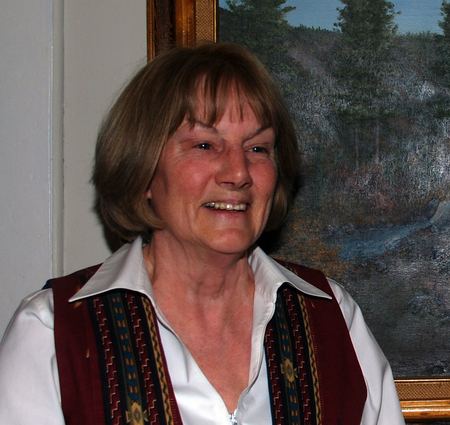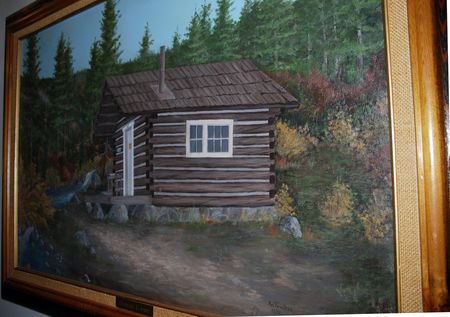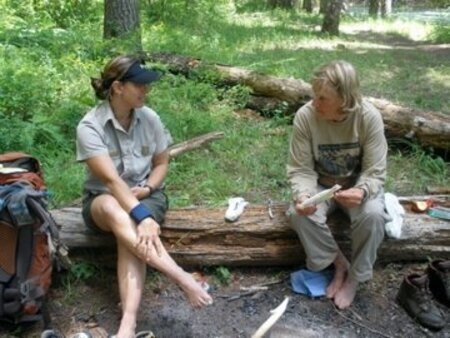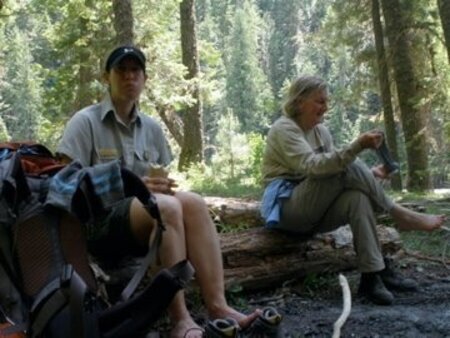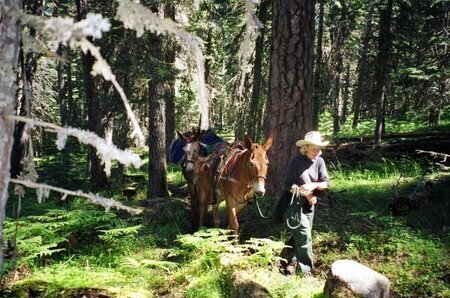Episode 10 : Wilderness Education : an interview with Connie Saylor Item Info
In this episode, titled “Wilderness Education,” Connie Saylor tells the story of the wilderness that drew her from Iowa where she was a schoolteacher. Since 1988, Connie has worked for the Forest Service in the Clearwater National Forest and the Selway-Bitterroot Wilderness. She did not lose her role as a teacher; instead she applied it to her work in the wilderness, organizing workshops to introduce teachers and students to wilderness, teaching guests about low-impact recreation, and building connections between the classroom and the wilderness. Connie was instrumental in helping to form the Selway-Bitterroot Frank Church Foundation as an early field leader and in training interns. Today, Connie still loves wilderness deeply, and works to educate others on the importance of preserving wild land for future generations to enjoy.
Episode 10 : Wilderness Education : an interview with Connie Saylor [transcript]
00:00:00:00 - 00:00:29:10 Debbie Lee or Jane Holman: Welcome to the Subway Bitterroot Wilderness History Project, which is made possible by a grant from the National Endowment for the Humanities. The University of Idaho, and Washington State University. Part of the project’s mission is to collect, preserve, and make public oral histories documenting the history and people of the Solway Bitterroot Wilderness. For more information, please visit our website at SPW lib argue idaho.edu.
00:00:29:12 - 00:00:54:10 Debbie Lee or Jane Holman: And then I think people, I think people get so much out of being in a wilderness setting. Once you take away cars and money and telephones, people are different and they are different to each other, I think. and and then they draw on things in themselves that maybe are a little rusty from our crazy life out here.
00:00:54:10 - 00:01:25:12 Debbie Lee or Jane Holman: Now, I think the ways that people get along when they’re isolated in a place like that, that they place that they want to be, are really it’s a wonderful thing.
00:01:25:15 - 00:01:50:00 Debbie Lee or Jane Holman: Thank you for joining us for the 10th episode of the South Bitterroot Wilderness History Project. In this episode, titled Wilderness Education, Connie Saylor tells the story of the wilderness that drew her from Iowa, where she was a school teacher. Since 1988, Connie has worked for the Forest Service in the Clearwater National Forest and the Subway Bitterroot Wilderness. She did not lose her role as a teacher.
00:01:50:00 - 00:02:21:27 Debbie Lee or Jane Holman: Instead, she applied it to her work in the wilderness, organizing workshops to introduce teachers and students to wilderness, teaching guests about low impact recreation, and building connections between the classroom and the wilderness. Connie was instrumental in helping to form the Selway Bitterroot Frank Church Foundation as an early field leader and in training interns. Today, Connie still loves wilderness deeply and works to educate others on the importance of preserving wild land for future generations to enjoy.
00:02:21:29 - 00:02:30:22 Debbie Lee or Jane Holman: So, Connie, how did you first come to this area? So a Bitterroot area.
00:02:30:24 - 00:02:56:21 Connie Saylor: It was a big chance. I was in living in Iowa. That’s where I was born, and I was in a workshop called American Wilderness Leadership School. Now, Iowa is one of the six states that does not have wilderness. So it’s pretty foreign to that part of the country. Although I was a rural person and grew up in the country, and that’s why I learned to love the land.
00:02:56:24 - 00:03:30:05 Connie Saylor: But I was in a wilderness leadership school, and there was a young woman there. It was the very first one in Iowa. As a matter of fact, there was a young woman there, Jill, and she had been a lookout at Powell Ranger Station because her brother had come out from Iowa and he was living in Lolo. So she came up for a summer and worked at the, Bear Mountain lookout, you know, Bear Mountain.
00:03:30:07 - 00:03:57:24 Connie Saylor: And she had taken some photographs and she had those with her. She showed me these photographs and I was just overwhelmed. Something went whang in my heart, and it was, I have to be in this place just right. Then I have to go there. And I remember driving out of the driveway and I. Pam, this is the stupidest thing you ever did.
00:03:57:24 - 00:04:28:29 Connie Saylor: You better just turn around and go back to little Essex, Iowa and not do this anymore. And I almost turned around. But I headed west, so I took my time driving along the way, I stopped at Cabela’s. It’s back when before Cabela’s was the gigantic thing it is now. They only had two stores there, so I stopped and I spent a half a day at Cabela’s buying a sleeping bag, hat, and whatever I thought I needed.
00:04:28:29 - 00:05:12:15 Connie Saylor: I wasn’t sure all the gear that you needed, but I. I still sleep in that sleeping bag to this day, so. I drove on out and I stayed in cheap motels a couple of nights along the way. I remember seeing an antelope give birth to a two of. Fawn, I guess you call them along the way. And, I was just enjoying the scenery, and I got to the summit between Montana and Idaho, you know, at the top.
00:05:12:15 - 00:05:40:24 Connie Saylor: And and I would. I got out of the I was picked up and I said, here I am. I almost kissed the ground where I said, okay. And then it said, Clearwater National Forest is this is where I’m going to work. So my first ten day hitch, I went in with a pack string and, even though I lived on a farm and had been around animals a lot, I really wasn’t that familiar with mules.
00:05:40:27 - 00:06:09:28 Connie Saylor: Now, we raised them and, I helped the Packer get my stuff together and was just fascinated with the whole procedure of packing, which I later learned to do myself. To my amazement. And we were busy. And he pointed up to the hills and he said, see up there in a you he said, it’s snowing there. He said, that’s where we’re going.
00:06:10:00 - 00:06:29:01 Connie Saylor: Okay. One thing I do remember driving down the highway. I was looking up into the hills. Now this is really dumb. But it was so steep. It was just so steep. And I thought, well, there’s no way you can get up in there. I didn’t know there were roads there. I didn’t know there were trails there. I thought, where am I going to work?
00:06:29:01 - 00:07:01:26 Connie Saylor: I can’t you can’t negotiate those hills now that’s pretty dumb. But there I was in the middle of them. For several more years. So the packer put me on a big, tall mule, and we took off for horse camp, which is about a ten mile trip up Boulder Creek that drains into the Luxor. And there’s a little cabin back there called Horse Camp.
00:07:01:26 - 00:07:34:28 Connie Saylor: See this picture right there? That’s horse camp. Yeah. And he dumped me off and said, I’ll see you in ten days. So I said, okay. And I really didn’t have any direction or orientation in to this job, so they dumped me off all by myself. I had a map and all of my hitches were by myself, and so I, I had never been there, of course, before.
00:07:34:28 - 00:07:52:28 Connie Saylor: So I had to just, figure it out on my own. And I probably learned things better by doing that than someone saying leading me by the hand. I had some some huge learning experiences that I obviously live through, but.
00:07:53:01 - 00:08:01:01 Debbie Lee or Jane Holman: So you how do you, teaching and wilderness merge like for you? I think the crossover.
00:08:01:06 - 00:08:33:04 Connie Saylor: I think it was a natural thing because part of my job description, excuse me description was education, which meant I was to make visitor contacts in the woods and, I was to spread the message of low impact camping and to educate the public who used the wilderness about what wilderness really is and and why we expect certain rules to be followed in the wilderness.
00:08:33:04 - 00:08:45:13 Connie Saylor: And part of it’s the philosophy of wilderness, and part of it is the actual physical use of the wilderness. And so it was my job to communicate that to the public.
00:08:45:15 - 00:08:53:02 Debbie Lee or Jane Holman: How, can you tell us a little bit about, reach a teacher to touch the world? Oh, or did I get that?
00:08:53:02 - 00:08:57:20 Connie Saylor: That’s right. Reach a teacher, touch the world.
00:08:57:23 - 00:09:02:02 Debbie Lee or Jane Holman: because that’s a pretty significant, initiative that you had.
00:09:02:02 - 00:09:32:20 Connie Saylor: Yes. It was really satisfying. When I worked in Iowa as a teacher, there was a stint there that I worked for the Department of Education in Iowa as the, assistant to the environmental education director for the state, and we taught environmental education or conservation education. I like to call it conservation education. a better choice of words, I think.
00:09:32:20 - 00:10:10:18 Connie Saylor: But we taught to teachers and showed them how to teach children about conservation and education. And while I was in that job, I wrote a grant proposal for taking teachers to the wilderness. And they would do actual work projects, clearing trail, rehabbing campsites, and the list goes on. But they would actually do physical labor in the woods, and then they would write curriculum while they were camped out there.
00:10:10:18 - 00:10:40:17 Connie Saylor: They would get ideas about how they would use wilderness education in their classrooms. So it ran the gamut of art teachers, PE teachers, whatever, and they would come up with ideas about implementing wilderness education. And either then or when they got back to the classroom in Iowa, they would write a lesson plan. And they submitted it to me.
00:10:40:17 - 00:11:11:08 Connie Saylor: And then they would report every two, excuse me weeks as to the progress and accomplishments, and then they would receive also college credit from the University of Northern Iowa for education. So it was a it was a great project. There were wonderful teachers who came out. There were wonderful ideas that, implemented wilderness education.
00:11:11:10 - 00:11:23:26 Debbie Lee or Jane Holman: To make, do you remember any of the projects that the teachers came up with to take back to the classrooms, like, do any stick out in particular?
00:11:23:28 - 00:11:31:00 Connie Saylor: It’s been a long time ago.
00:11:31:02 - 00:12:10:22 Connie Saylor: I remember an art teacher took. Photographs of the wilderness area and explained to her students what wilderness was, and she had them create projects, related to art. I remember a homework teacher. She had her students make placemats that showed wilderness scenes. And then she, she had projects in cooking, you know, with, like, backcountry cooking and whatever for her students.
00:12:10:24 - 00:12:41:22 Debbie Lee or Jane Holman: That’s awesome. So you did you were saying that you started out hiking alone. And you I know that you prefer that now. And some people might think, a woman hiking alone. How could you like, do you get frightened. it’s. How do you handle that. Not just as a woman but as a person. Just kind of the loneliness aspect of it.
00:12:41:24 - 00:13:20:12 Connie Saylor: I’m a loner by nature, although I do like people and I enjoy being with people. I like being by myself a lot, and that’s very important to me. And I don’t think loneliness was so much a factor. I, I would see people occasionally passing by and whatever. Sometimes I would go 4 or 5 days without seeing someone, but, the fearfulness, I don’t remember really being afraid of anything.
00:13:20:12 - 00:13:56:21 Connie Saylor: I’m. I’m. I’m a spiritual and faithful person. And I kind of gave over my life to, you know, there’s there’s God taking care of me, and I know that. But I did learn to. And I don’t remember being fearful. There were lightning storms and there were creek crossings and there were lots of challenging things physically. But I’m naturally an impatient person, and this taught me, since I was by myself, to be very careful about where you put your feet.
00:13:56:21 - 00:14:26:21 Connie Saylor: You know, if you get hurt here, there’s no way anybody’s going to help you here on your own. So it taught me to plan ahead about how it was going, how I would negotiate this or that, or how I would deal with a water supply or, these things and that kind of thing. I just loved being in that place so much.
00:14:26:23 - 00:14:56:12 Connie Saylor: It just took care of me. You know, it’s a pretty overpowering feeling to look up into those hills, and especially being a flatlander like I was, I still am in awe of the power of those mountains and the power of the weather and the creeks and and just the sheer, hugeness of it. And, and the fact that we’re not in control of anything.
00:14:56:14 - 00:15:22:28 Debbie Lee or Jane Holman: So you even after you quit working officially for the Forest Service, you got right back involved in teaching and educating people how to, work in the wilderness. Can you talk about what you do now with, interns and volunteers through the Sony Bitterroot Foundation?
00:15:23:00 - 00:15:57:14 Connie Saylor: I had to get back. I couldn’t I couldn’t leave, and I guess I’d have been selfish on my part, but I really believed in the Solway Bitterroot Foundation. It began to be formed just as I was. starting to end my career there. So it overlapped. And the Selway Bitterroot Foundation was just getting getting on its feet and, really in its infancy.
00:15:57:14 - 00:16:00:28 Connie Saylor: And so.
00:16:01:00 - 00:16:43:13 Connie Saylor: We had we had several projects going on. I think people didn’t realize how many projects we had before it really came in to being as it is now. But we had many, many projects and I was the only field leader there. And so I was still really busy in the woods with, different projects. And that made me happy because I, I got to be there and, then I got to help train, the wilderness interns when Rob Mason came on board and, and really transformed the.
00:16:43:15 - 00:16:54:27 Connie Saylor: So we bitterroot Frank church Foundation into, the organization that is becoming,
00:16:55:00 - 00:17:29:11 Connie Saylor: I helped in getting getting that park going, and then I’m in a limited, capacity. Now. There will be a group from Iowa coming in July, and I’ll be with them, but it’s still an opportunity to expose other people to the wilderness. And, you know, it’s kind of an a the education kind of takes care of itself if you can get them there, if you can get people to the wilderness, they become advocate.
00:17:29:11 - 00:17:47:15 Connie Saylor: That’s already they understand, they get it. If you just get the people to that place, then the rest of the work is done for you. It’s, I don’t maybe not work, but the education is done for you. They get it.
00:17:47:18 - 00:18:10:17 Debbie Lee or Jane Holman: Thank you for joining us for this episode of the Selway Bitterroot Wilderness History Project, which has been made possible by the National Endowment for the Humanities. The University of Idaho, and Washington State University. The project coordinator is Debbie Lee, recorded and produced by Aaron Jepson.
00:18:10:19 - 00:18:12:03 Debbie Lee or Jane Holman: Which.
Gallery
- Title:
- Episode 10 : Wilderness Education : an interview with Connie Saylor
- Creator:
- Debbie Lee; Jane Holman; Connie Saylor
- Date Created (ISO Standard):
- 2011-05-06
- Description:
- Interviewee: Connie Saylor | Interviewers: Debbie Lee and Jane Holman | Date: May 6, 2011 | Location: Nezperce, Idaho | Topic: Education in Wilderness | In this episode, titled 'Wilderness Education,' Connie Saylor tells the story of the wilderness that drew her from Iowa where she was a schoolteacher. Since 1988, Connie has worked for the Forest Service in the Clearwater National Forest and the Selway-Bitterroot Wilderness.
- Subjects:
- podcasts education conservation women
- Section:
- Wilderness Voices
- Location:
- Selway-Bitterroot Wilderness (Idaho and Mont.)
- Publisher:
- Wilderness Voices, The Selway-Bitteroot Wilderness History Project, https://selwaybitterrootproject.wordpress.com/
- Original URL:
- https://selwaybitterrootproject.wordpress.com/2011/07/22/wilderness-education/
- Source Identifier:
- Selway-Podcast-ep10
- Type:
- Sound
- Format:
- audio/mp3
- Language:
- eng
- Preferred Citation:
- "Episode 10 : Wilderness Education : an interview with Connie Saylor", The Selway-Bitterroot Wilderness History Project, University of Idaho Library Digital Collections, https://www.lib.uidaho.edu/digital/sbw/items/sbw292.html
- Rights:
- Copyright: The Selway-Bitteroot Wilderness History Project. In Copyright - Educational Use Permitted. For more information, please contact University of Idaho Library Special Collections and Archives Department at libspec@uidaho.edu.
- Standardized Rights:
- http://rightsstatements.org/vocab/InC-EDU/1.0/

